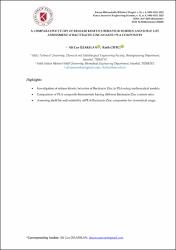A Comparative Study of Release Kinetics Behavior Models and Shelf Life Assessment of Bacitracin Zinc-Loaded Pla Composites
Künye
ÖZARSLAN, Ali Can & Fatih ÇİFTÇİ. " A Comparative Study of Release Kinetics Behavior Models and Shelf Life Assessment of Bacitracin Zinc-Loaded Pla Composites". Konya Journal of Engineering Sciences, 11.4 (2023): 1006-1015.Özet
Mathematical modeling aims to simplify the complex process of drug release and to gain knowledge about the release mechanisms specific to a given material system. Consequently, a mathematical model focuses primarily on one or two important factors. Drug release aims to maximize the bioactivity of both naturally derived and synthetically derived macromolecules, thus increasing their clinical applicability and improving the overall quality of life. This study focused on fabricating PLA composites with different weight percentages of Bacitracin Zinc (0.5, 1.0, and 2.0) and evaluating their potential as a drug delivery system. To understand the release mechanism of Bacitracin Zinc from the PLA composites, we developed a Franz diffusion kinetic model and a mathematical model for cumulative release kinetics. The Franz diffusion model was utilized to analyze the release behavior of the PLA/Bacitracin Zinc composite structure. The results indicated a sustained release rate, following a Zero Order release kinetics pattern. Furthermore, the shelf life of the composite structure was determined to be 125 days. Python programming was employed to model the release behavior and estimate the shelf life of Bacitracin Zinc (0.5, 1.0, and 2.0) incorporated into the PLA matrix to compare different weight percentages' behavior and shelf life.



















